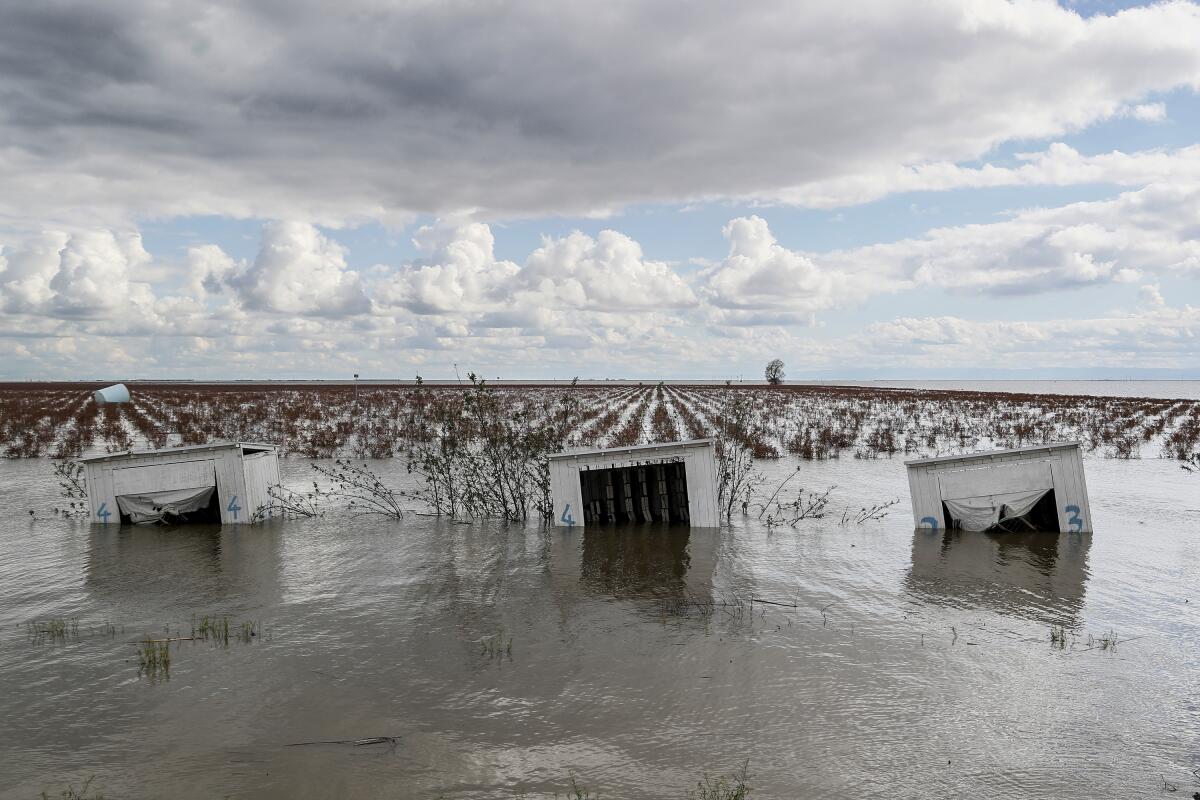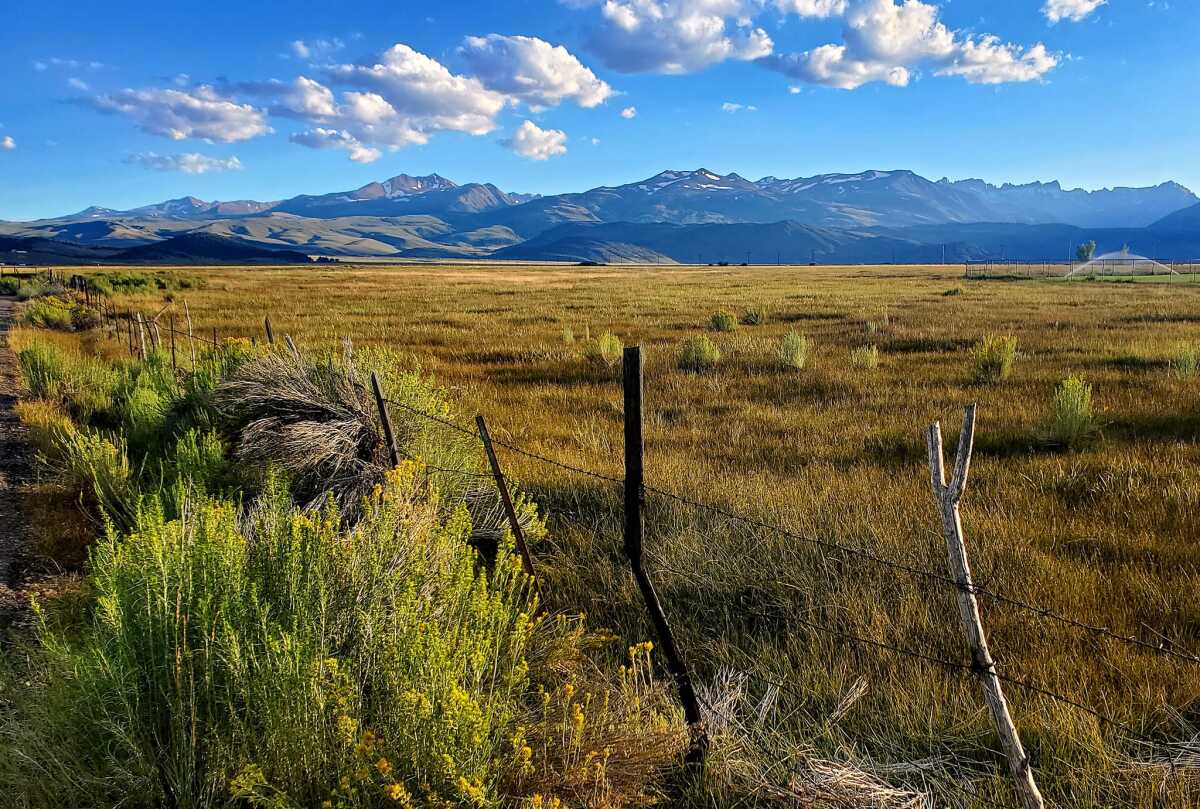Amid a growing number of threats, can the San Joaquin Valley adapt to climate change?

- Share via
Good morning. It’s Wednesday, Oct. 25. I’m Hayley Smith, an environment reporter at The Times, bringing you today’s edition of Essential California. Here’s what you need to know to start your day.
- If California is a front line of climate change, the San Joaquin Valley is ground zero. Can it adapt?
- California DMV pulls permits for Cruise’s driverless cars
- Officials urge California residents to brace for flooding as El Niño looms
- And here’s today’s e-newspaper
Sign up for Essential California
The most important California stories and recommendations in your inbox every morning.
You may occasionally receive promotional content from the Los Angeles Times.
Can the San Joaquin Valley adapt to climate change?
In the summer of 2022, I found myself standing atop dry, cracked dirt beneath the white-hot sun of California’s San Joaquin Valley. The state was three years into a punishing drought, and I was interviewing a Tulare County resident whose well had run dry. The man had no reliable source of drinking water, and he wasn’t sure when or how he would get one.
Less than a year later, I found myself in the valley once again — only this time, I was standing at the edge of Tulare Lake, which was reborn amid one of California’s wettest winters in recent memory. The lake had been drained for agriculture more than a century earlier, but the pounding rain overtopped rivers and burst through levees to fill it once again. I could see the tops of telephone poles and almond trees poking up from its stagnant depths.
The valley, it seemed to me, can’t catch a break.
In fact, residents there are dealing with a dizzying array of climate challenges, often at the same time. In addition to whiplash-inducing swings from extreme drought to extreme flooding, the valley consistently suffers from the worst air quality in the nation, which can be made worse by lung-searing smoke from nearby wildfires. Overuse of the valley’s groundwater has translated into some of the worst land subsidence on earth, and all the while, temperatures continue to rise.
If California is a front line of climate change in America, the San Joaquin Valley may well be ground zero.
But unpacking why that is the case — and what can be done about it — revealed a complex web of factors. Over the last several months, I made multiple trips to the valley and spoke with residents, academics, politicians, farmworkers and community leaders to form a clearer picture of a region in flux.
I learned that over time, the valley underwent a dramatic shift from a humid landscape to one that is rapidly aridifying — a transition that weakened its natural ability to cope with climate change. The region’s transition toward industrial agriculture, and its central role in the state’s oil and gas production, further taxed its resources.
Some of the experts I spoke to said the farmworkers and low-income communities that make up a large portion of the valley’s population aren’t always top-of-mind for lawmakers in Sacramento, and don’t have the same leverage as their coastal counterparts in San Francisco and L.A.
The region is also the land of Kevin McCarthy, the recently ousted Republican speaker of the House. As of this writing, he continues to represent the 20th Congressional District that comprises much of the valley, including large swaths of Kern, Tulare, Kings and Fresno counties. McCarthy has called for increased domestic fossil fuel production and a less aggressive approach to slashing the carbon emissions that are contributing to global warming.
These and other elements have culminated in the valley’s worsening climate crisis. But the story isn’t about dead ends — it’s also about solutions.
The valley has transformed itself before, and in order to survive, it must do so again. Fortunately, there are a lot of smart people working on these challenges.
But there is still work to do. An overhaul of agricultural practices and continued investment in renewable energy are key pieces of the valley’s future. Revived ecological habitats, multi-benefit land use projects and the creation of “buffer zones” to help separate people from potential hazards can improve life there and provide new opportunities for jobs, restaurants, housing and commerce.
For better or for worse, California is a leader when it comes to climate change — sometimes as the first to feel its impacts, sometimes as the first to pioneer solutions. What the San Joaquin Valley does next could be a case study for the rest of the nation.
Today’s top stories

California businesses
- California DMV pulls permits for Cruise’s driverless cars over safety concerns.
- A $7.5-million find: Overlooked Getty estate sale map turns out to be 14th century treasure.
- California sues Facebook parent Meta over alleged harm to young people.
- A third hotel reaches a deal with striking workers as Long Beach and Pasadena employees walk out.
Climate and environment
- Officials urge California residents to brace for flooding as El Niño looms.
- First measurable snow of the season heading for California.
War in the Middle East
- Hallucinatory anguish and moments of hope: How Israel waits for news of Hamas-held hostages.
- How the Israel-Hamas war is dividing Hollywood.
- For Californians whose relatives were kidnapped in Israel, the uncertainty is ‘an unimaginable nightmare.’
- Amid criticism, the Biden administration makes plea for civilians trapped in Gaza under Israeli bombardment.
- WGA West weighs in on the Israeli and Palestinian deaths.
More big stories
- Newsom meets with President Xi Jinping in Beijing amid troubled U.S.-China ties.
- The House Republican civil war shows Trump’s power — and its limits.
- Richard Roundtree, star of the 1970s ‘Shaft’ film franchise, has died at 81.
- Another Trump lawyer, Jenna Ellis, pleads guilty in Georgia 2020 election subversion case.
- Racist comments uttered at San Bernardino council meeting: Did city take too long to apologize?
- Manager Bob Melvin ditches Padres for Giants. He’s a facsimile of Bruce Bochy.
- Video game company saves Kobe and Gianna Bryant mural in downtown Los Angeles.
- Off-duty pilot may have been on psychedelic mushrooms when he tried to shut off plane engines, FBI says.
- Lakers’ late rally falls short in season-opening loss to the Nuggets.
Get unlimited access to the Los Angeles Times. Subscribe here.
Commentary and opinions
- Letters to the Editor: The state of LAUSD? Falling test scores. Declining enrollment. Chronic absenteeism.
- Editorial: Jailed Angelenos die, deputies shrug. Will this daily routine never end?
- LZ Granderson: When journalists are killed in Gaza, more lives are at stake.
- Commentary: ‘This can’t happen again.’ Greg Vanney faces pressure to finally fix the Galaxy.
- Michael Hiltzik: Why anti-vaxxers are pretending a flawed study on vacccine deaths has been vindicated.
- J. Brady McCollough: College football contenders and pretenders: Who has a legit shot at a national title?
- Jenn Harris: Tiffani Thiessen fed me fried chicken, cheesy enchiladas, beef jerky and a Michelin tasting menu. We had leftovers.
Today’s great reads
USC’s Jamil Muhammad dedicated his life to being a QB. Now he’s taking them down. In L.A., he’s thriving as the Trojans’ top pass rusher, with six sacks in seven games. As he bursts into the backfield, speeding around blocks and trampling past offensive tackles, you’d be hard-pressed to believe this wasn’t the plan all along.
Other great reads
- Looking for a date? In Taiwan, the government is here to help.
- Over a Greek dish, John Stamos reflects on how his parents, grief and sobriety shaped his memoir.
- Over 30 years ago hip hop inspired me to pick up a spray can. It saved my life.
- Every taquería needs a taquero. In Atlanta, they’re hard to find.
How can we make this newsletter more useful? Send comments to [email protected].
For your downtime

Going out
- 🍽️ The best places to eat and drink in L.A. right now, according to our food writers.
- 🎭 ‘Birds of North America’ — on stage at Odyssey Theatre — locks its characters in a cage of dramatic constraints.
- 🎃 Hate that Halloween is only one day? At these L.A. shops, it’s always spooky szn.
Staying in
- 🎮 The dose of self-care you didn’t know you needed? Playing the new ‘Super Mario Bros. Wonder.’
- 🎤 Here’s the single most definitive, conclusive and indisputable Britney Spears karaoke power rankings of all time.
- 🎃 The official De Los ‘espooky season’ playlist.
- 🧑🍳 Here’s a recipe for buttermilk biscuits.
- ✏️ Get our free daily crossword puzzle, sudoku, word search and arcade games.
And finally ... a great photo
Show us your favorite place in California! Send us photos you have taken of spots in California that are special — natural or human-made — and tell us why they’re important to you.

Today’s great photo is from Rick LeFlore of Davis. Rick writes:
The east side of the Sierra Nevada is vast, mostly lonely and starkly beautiful while playing such a large role in California’s watershed and western movement history. One of my favorite east side “escapes” from the well known tourist spots is the Sonora Pass region as it drops precipitously to the east of the Sierra Nevada crest. Life just feels timeless here.
Have a great day, from the Essential California team
Ryan Fonseca, reporter
Elvia Limón, multiplatform editor
Kevinisha Walker, multiplatform editor
Laura Blasey, assistant editor
Check our top stories, topics and the latest articles on latimes.com.
Sign up for Essential California
The most important California stories and recommendations in your inbox every morning.
You may occasionally receive promotional content from the Los Angeles Times.





